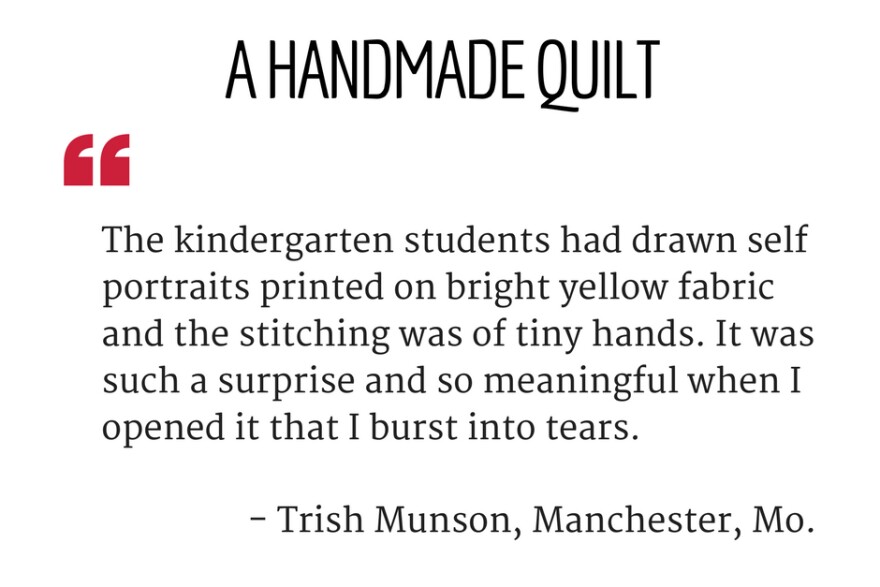It can be a parade of baked goods into classrooms the week before winter break. Gift cards tend to stack up on teachers’ desks. But sometimes, a gift overwhelms a teacher — and it’s kept for decades.
In the final days before winter break, teachers and students will wrap up the fall semester and dash home to celebrate the holidays. Before that, many students will present to their favorite teachers gifts, large and small; hand-made and store-bought; expensive and not-so-much.
St. Louis Public Radio asked teachers in the region to share stories of their most memorable gifts from students. Here are a few of our favorites:
A hidden message in the art
In an otherwise sterile classroom with rows of Mac computers, a colorful painting hangs over Otto Schultejans desk. It’s a little crooked.

The painting was given to Schultejans, a 46-year-old teacher at Maplewood Richmond Heights High School, several years ago from a student who was hard to motivate and threatening to drop out. But then he found out he connected with his pupil.

On the canvas is the lyric from a song, though the abstract painting is “a hot mess” that even Schultejans couldn’t interpret at first. It’s a line from the Beatles’ song “Across The Universe” that reads: “Nothing’s going to change my world.”
“By the time she was a senior I could tell this was kind of her tongue-in-cheek way of saying ‘yeah, you actually did change my world,’” he said.
The student stayed in high school. She even went on to college. “Sometimes you miss but sometimes you hit,” he said. “And you make a real difference in a kid’s life.”
An intricate ornament

During three decades of teaching, Ladue Middle School science teacher Hugh McMonigle received a lot of cookies from his students — which “tend to get eaten really fast.”

But there’s one gift the 55-year-old saved from his early years as an educator in Modesto, California: an embroidered three-sided heart ornament.

“If you saw it, you’d go just ‘woah.’ This is somebody who is incredibly skilled with needlepoint and it’s just a beautiful little heart,” he said.
The gift came from the family of a Vietnamese refugee with little money. It’s the first ornament McMonigle hangs on his Christmas tree every year. “It will be up there until I die,” he added.
Getting gifts like that make McMonigle feel loved and appreciated.
“These people took a skill they had and spent time making something for me to thank me for helping their kid,” he said.
A collection of thank you notes

A goldfish may be the most peculiar thing students have brought into 30-year-old Molly Beck’s Ladue Horton Watkins High School classroom. The fish died a few years ago.
Still in her classroom is a book of handwritten notes from students on her debate team. They’re bound along with pictures of the students. The book sits on a shelf above her desk, within easy reach.
“Those notes from students and being able to sit and appreciate that moment, that’s really helpful,” Beck said. “I probably reach for this book at least two or three times a month.”
A piggy bank with a chip in the ear

When Amanda Berndt got a job in Franklin County early in her career, it presented a bit of “culture shock.”

Berndt, now a special education teacher with St. Louis County Special School District, still remembers a girl who joined her second grade class just a few weeks before Christmas.

“She was sweet,” Bernt, 40, remembers. “And you could tell things were not always easy at home; she was always a little sad, that sort of thing.”
The shy girl brought something wrapped in a crumpled blue bag, delivering it with a beaming smile. Inside was a piggy bank.
“It’s not new,” Berndt said about the small purple pig. “There’s a little chip on the ear and it’s kind of dirty.”
Berndt says she’s never been able to let go of the moment — or the piggy bank, though it’s not about the gift.
“(Students) touch you in ways you don’t see coming,” she said. “The ones that are hard, the ones that are easy, they all touch you in one way or another.”
Follow Ryan on Twitter: @rpatrickdelaney
Inform our coverage
This report was prepared with help from our Public Insight Network. Click here to learn more about how you can be a part of our conversations. Click here to read responses from more teachers.



